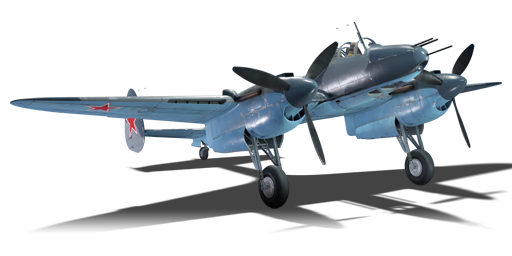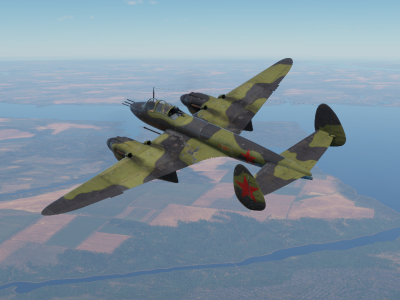


It was introduced during Update 1.95 "Northern Wind" in the Operation F.R.O.S.T. event. One of the last projects of the Polikarpov design bureau, the TIS MA is a unique and deadly aircraft. Its general configuration is similar to the famous Pe-2/3 "Peshka", having two inline engines slung under the wings, a gunner in the back of the cockpit, and twin vertical stabilizers mounted at the ends of the horizontal stabilizers. However the TIS MA is a different animal compared to the Pe-3 heavy fighter. While the Pe-3 was a hastily adapted variant of the Pe-2 dive bomber, the TIS MA was a purpose designed heavy fighter. It is smaller and slimmer, leading to a less bulbous and more insectoid appearance. More importantly, its flight characteristics and firepower are much improved; pilots who struggled with the Peshkas's poor manoeuvrability and mediocre armament will be pleasantly surprised by the TIS MA's decent handling and burning hatred for any enemies foolish enough to find themselves in front of it.
flaps
flaps
flaps
brake
| Belt | Belt filling | Armor penetration (mm) at a distance: | |||||
|---|---|---|---|---|---|---|---|
| 10 m | 100 m | 500 m | 1000 m | 1500 m | 2000 m | ||
| AP-T/HEI-T | 71 | 68 | 57 | 46 | 37 | 30 | |
| HEI-T | 9 | 8 | 7 | 6 | 5 | 5 | |
| AP-T | 71 | 68 | 57 | 46 | 37 | 30 | |
| Belt | Belt filling | Armor penetration (mm) at a distance: | |||||
|---|---|---|---|---|---|---|---|
| 10 m | 100 m | 500 m | 1000 m | 1500 m | 2000 m | ||
| FI-T/AP-I | 28 | 24 | 14 | 7 | 4 | 2 | |
| FI-T/HEF/AP-I/FI-T | 28 | 24 | 14 | 7 | 4 | 2 | |
| HEF/FI-T/AP-I | 28 | 24 | 14 | 7 | 4 | 2 | |
| FI-T | 4 | 4 | 4 | 4 | 4 | 4 | |
| AP-I/FI-T/AP-I/AP-I | 28 | 24 | 14 | 7 | 4 | 2 | |
| AP-I/HEF/HEF/FI | 28 | 24 | 14 | 7 | 4 | 2 | |
| Belt | Belt filling | Armor penetration (mm) at a distance: | |||||
|---|---|---|---|---|---|---|---|
| 10 m | 100 m | 500 m | 1000 m | 1500 m | 2000 m | ||
| HEFI-T/HEFI-T/APHE | 59 | 57 | 48 | 38 | 31 | 24 | |
| HEFI-T | 8 | 7 | 6 | 5 | 5 | 5 | |
| HVAP-T | 76 | 73 | 59 | 46 | 36 | 28 | |
| APHE | 59 | 57 | 48 | 38 | 31 | 24 | |
| Belt | Belt filling | Armor penetration (mm) at a distance: | |||||
|---|---|---|---|---|---|---|---|
| 10 m | 100 m | 500 m | 1000 m | 1500 m | 2000 m | ||
| FI-T/AP-I | 28 | 24 | 14 | 7 | 4 | 2 | |
| FI-T/HEF/AP-I/FI-T | 28 | 24 | 14 | 7 | 4 | 2 | |
| HEF/FI-T/AP-I | 28 | 24 | 14 | 7 | 4 | 2 | |
| FI-T | 4 | 4 | 4 | 4 | 4 | 4 | |
| AP-I/FI-T/AP-I/AP-I | 28 | 24 | 14 | 7 | 4 | 2 | |
| AP-I/HEF/HEF/FI | 28 | 24 | 14 | 7 | 4 | 2 | |
| Belt | Belt filling | Armor penetration (mm) at a distance: | |||||
|---|---|---|---|---|---|---|---|
| 10 m | 100 m | 500 m | 1000 m | 1500 m | 2000 m | ||
| T/AP/AP/IAI | 32 | 30 | 22 | 15 | 11 | 7 | |
| API-T/AP/AP/AP-I(c) | 34 | 32 | 24 | 17 | 12 | 8 | |
| API-T/AP-I | 29 | 27 | 20 | 13 | 9 | 6 | |







 2 x (55 / 100 / 240) %
2 x (55 / 100 / 240) % 
 2 x 136 %
2 x 136 % 

Flight performance | |
|---|---|
Weaponry | |||
|---|---|---|---|
